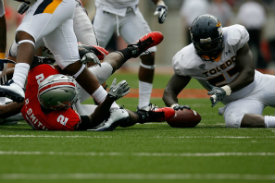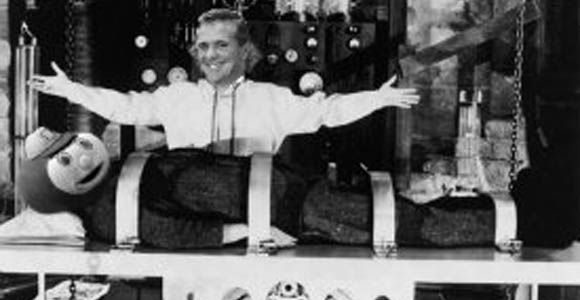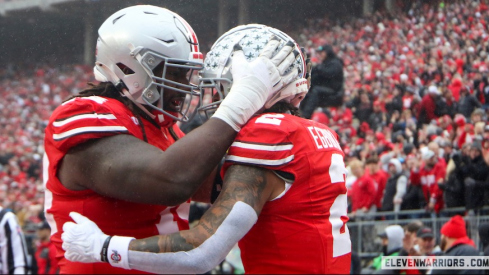Let's get weird, people.
2012 was kind of a strange year for the Buckeyes -- a new offensive system, the quarterback was the best and most exciting runner on the team, a new coaching staff, a defense that required a senior fullback to switch to full time linebacker half way through the season, and a bowl-less, but perfect, 12-0.
The Buckeyes were alone as the only FBS team to not lose a game, despite finishing the year as the 23rd ranked S&P+ team, including just the 25th best defense. The top Tressel-era teams consistently finished in the top-5 of defensive efficiency metrics, yet the 2012 squad managed perfection with relatively pedestrian statistics.
With only twelve games to go on, I can say that Urban Meyer is a machine and he wants his team to be a machine as well. Urban resuscitated the offense following the disastrous 2011 interim period, but there were quite a few odd statistics that indicate that the machine still had a few ghosts to shake.
Below I break down the four strangest statistics from the 2012 season with an eye towards how the team will evolve in 2013.
1. Unlucky Bucks
The Buckeyes went 12-0, but it wasn’t without close calls. The Michigan State, Indiana, Purdue, Wisconsin, and Michigan games all ensured that even bowl-less seasons could give heart attack-levels of anxiety.
While the secondary got out of position, injuries took their toll, and the passing game was still mediocre, some of the close calls can be explained due to just plain unluckiness.
Fumbles and fumble recoveries are as close to random as random gets in football, so they’re as good of a measure for “luck” as any. Bill Connelly notes that the Buckeyes played well – what we could call their average performance – in all but one close game, but were set back because of random bounces of the football.
One thing to note about Ohio State is that some of the close games were close, in part, because of luck. As you see at the bottom of this post, the Buckeyes suffered minus-2.8 points per game of turnovers luck...Life was harder because the bouncing ball wasn't landing in Buckeye hands, and despite some seemingly shaky results, Ohio State only played at a below-average level once (against California). Plus, they got better as the season progressed, which is always a good sign for a young team.
...But the turnover oddities are nothing new for Meyer teams. In 2009, Florida recovered just 25 percent of all fumbles. In 2004-05, Meyer's Utah and Florida teams recovered 67 percent. Only twice since 2004 have Meyer's teams gravitated into the 45-55 percent range.
While that’s not necessarily news for Urban Meyer’s teams at Florida, there shouldn’t be a real ex ante reason for Meyer’s teams to not recover fumbles. This isn’t just a Rod Smith problem – it’s just where defenders happen to be during a fumble.
We don’t have any reason to think that the Buckeyes’ bad fumble luck will continue into 2013, whether Rod gets the start at running back or not.
2. Who Needs the Yards?
One of the odder things I found when looking at offensive metrics was that the Buckeyes were extremely efficient with their drives despite not accruing record-setting yardage.
The Buckeyes’ points per play, yards per point, and red zone percentage data all indicate that the Buckeyes were stellar at getting points out of their drives. The Buckeyes rarely settled for field goals – Drew Basil got the majority of his work for the whole season against Michigan alone.
The Buckeye offense was fourth and ninth in the country in the two points related metrics, but 33rd in yards per play. This view is corroborated by the Buckeyes’ stellar red zone percentage – 88% – which was eighteenth in the country.
 The ball hasn't bounced the Buckeyes' way in a while
The ball hasn't bounced the Buckeyes' way in a while 3. Second Quarter Stunnas
As efficient as the offense was, it was one of the slowest out of the gate, posting the 85th most efficient offense during the first quarter.
One theory is that Braxton needed a little running room in order to get his passing under control, another that the Buckeyes didn’t have the right emotion or jitters immediately before the game. What the case may be, the Buckeyes started off slowly, only to explode in the second quarter. The offense rocketed up to the second most efficient offense in the country in the second quarter, then leveled off as the 25th and 33rd ranked unit in the third and fourth quarters, respectively.
This a truly strange statistic, but one that speaks to the quality of offensive strategic adjustments and the mindsets of the players, who got more comfortable as the game went on.
It certainly doesn’t hurt to have a MENSA genius as an offensive coordinator – a guy who can pull the right strings to get the offense rolling after a slow start. For instance, during the Nebraska game, the Buckeyes only managed seven points in what first looked like a plodding Big Ten matchup. However, the offensive line began opening up holes and Braxton and Hyde led a 28-point second quarter.
I got the sense that a mid-20s ranking is about right overall for the Buckeye offense (based upon efficiency and big play data) so the explosive second quarters were certainly weird in 2012.
4. Sack Happy
For a guy so quick on his feet, Braxton was sacked far more than you might think in 2012.
Braxton was simultaneously capable of running around the entire field, darting through windows that were only open for a millisecond, while getting sacked on the very net play.
Connelly notes that Braxton was sacked on one of every 10 pass attempts last season, implying that there were times when Braxton was unable to locate an open receiver or make a fast read in the passing game.
He had the benefit of an experienced and mean offensive line, but even this All-American squad is only coached to block for 4-6 seconds of relentless effort. Again, part of the blame may be scattered between Braxton, the line, and the receivers, but Urban will certainly hope that defenses will be a little less sack happy in 2013.



